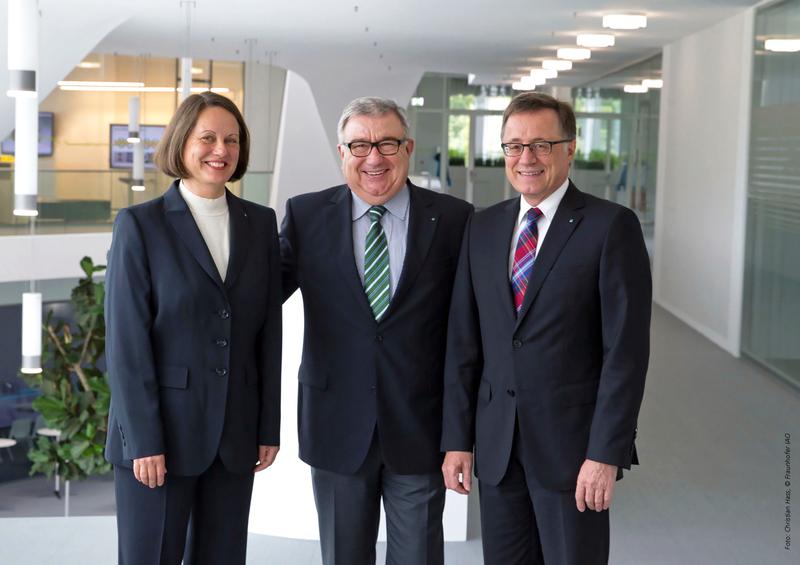Change in leadership at Fraunhofer IAO
Wilhelm Bauer to succeed Dieter Spath on October 1
Prof. Dr. Dieter Spath, long-standing director of Fraunhofer IAO and of the IAT at the University of Stuttgart, will become chairman of the Management Board for the WITTENSTEIN Group on October 1, 2013. Prof. Dr. Wilhelm Bauer, previously deputy director, will take over as acting director of both institutes. Apl. Prof. Dr. Anette Weisbecker will assume the role of deputy director.
After more than ten successful years as director of the Fraunhofer Institute for Industrial Engineering IAO and of the Institute for Human Factors and Technology Management IAT at the University of Stuttgart, Prof. Dr. Dieter Spath is leaving to join the WITTENSTEIN Group on October 1, 2013. He will be succeeded by Prof. Dr. Wilhelm Bauer, who will serve as acting director. Apl. Prof. Dr. Anette Weisbecker, previously member of the board of directors with responsibility for the Information and Communication Technology business unit, will assume the role of deputy director. By appointing a joint institute director, the Fraunhofer-Gesellschaft and the University of Stuttgart are continuing an established tradition that combines university-level basic research, application-oriented science and business practice.
Prof. Spath was visibly moved during the official handing-over ceremony, during which he spoke of his close ties to the institute. He has every confidence in the man who will succeed him in office, his long-standing deputy director Prof. Wilhelm Bauer: “After working closely together for so many years, I’m pleased to be passing the reins into the competent hands of Wilhelm Bauer. He brings the right combination of experience, visionary ideas and drive to the role,” said Spath. Wilhelm Bauer, a qualified ergonomist, is looking forward to the challenges ahead, and already has plans to drive forward a number of topics centering on “people, work and technology” in his new role as acting director. He considers rapid technological and social development to be the motive force for research activities: “New technologies are radically altering the way we will live and work in future. Our interdisciplinary research teams help companies to implement these new technologies,” said Bauer. We live in a world in which people, products and machines are becoming increasingly connected. Bauer sees great potential for the future in this networked world, and emphasizes the importance of making the most of the opportunities that digitization affords to support people in the best possible way. He added that “this requires visionary concepts, systematic processes and solutions that are suitable for practical application.” The Center for Virtual Engineering ZVE that he set up last year already provides the space in which to develop these ideas.
Besides his internationally recognized projects related to technology and work research, Wilhelm Bauer has launched pioneering research projects as part of various initiatives and networks. These include the “Morgenstadt – city of the future” initiative, which is led by Fraunhofer IAO and which pools the expertise of numerous Fraunhofer Institutes to work on solutions for tomorrow’s sustainable, life-enhancing, and flexible urban environments. Fraunhofer IAO has set the course for Industry 4.0 with its industry working group and guideline study into the future of manufacturing. The institute is also engaged in finding ways of taking electromobility to the next level, conducting numerous research projects as part of Baden-Württemberg’s “LivingLab BWe mobil” electromobility showcase initiative and carrying out research as one of 80 partners integrated in the South-West Electromobility Cluster of Excellence. This work is complemented by the new woman at the top, Anette Weisbecker, and her research into the potential for cloud technologies to benefit the German economy. As the lead institute in the Fraunhofer Cloud Computing Alliance, Fraunhofer IAO works with partners from industry and the scientific community to tackle the various challenges posed by this technology and its potential uses.
Some 500 employees – predominantly engineers, computer scientists, economists and social scientists – all work together under the joint institute directorship of Fraunhofer IAO and the IAT at the University of Stuttgart. Their common aim is finding solutions to make the world a better place to live in future, solutions for innovation and growth, and solutions that ensure sustainable development for both society and the environment. Modern offices, laboratories and demonstration centers covering over 14,000 square meters of space are available to handle research projects.
Brief profile of Hon.-Prof. Dr.-Ing. Wilhelm Bauer
Prof. Bauer studied at the University of Stuttgart, focusing on industrial engineering, work science and data processing. He has been deputy director since 2009, and is responsible for the Company Development and Work Design business. His research centers on questions related to the way life and work will develop in future. As executive director of Fraunhofer Italia Research s.c.a.r.l. he has been actively involved in building up applied innovations research at the Fraunhofer Innovation Engineering Center IEC in Bolzano, Italy. He has written more than 250 scientific and technical papers.
Brief profile of apl. Prof. Dr.-Ing. habil. Anette Weisbecker
After studying computer science at Technische Universität Darmstadt, Prof. Weisbecker worked in industry as a systems analyst. She joined Fraunhofer IAO in 1988 as a researcher in the Information and Communication Technology business unit. She has been a member of the board of directors since 2001, and became head of the Information and Communication Technology business unit in 2009. She is the author of more than 270 scientific and technical papers.
Contact
Fraunhofer IAO, Press and Public Relations
Phone +49 711 970-2124
presse@iao.fraunhofer.de
www.iao.fraunhofer.de
Weitere Informationen:
http://www.iao.fraunhofer.de/lang-en/press-and-media/iao-news/1070-change-in-leadership-at-fraunhofer-iao.html
Die semantisch ähnlichsten Pressemitteilungen im idw


